Monkey-faced Owls
Mammalian Hybrids
This page was a draft for a chapter that has now been published in its finished form in my book Telenothians, which is available here.
|
What is not deemed miraculous when it first comes into knowledge? How many things are judged impossible before they actually occur?
—Pliny
Natural History, 7.1.7 |
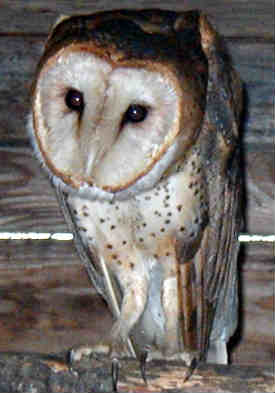 Barn Owl (Tyto albo), also known as the Monkey-faced Owl
Barn Owl (Tyto albo), also known as the Monkey-faced Owl
The Barn Owl (Tyto albo), pictured at right, is also known as the Monkey-faced Owl. Thus, anyone who had never seen a barn owl and had only heard it referred to by the name monkey-faced owl, might conjure up images of a harpy-like creature with a human- or monkey-like face and the body of a bird of prey—a rara avis indeed. But, of course, barn owls are not thought of as actual monkey-owl hybrids. They’re called monkey-faced simply because their faces are somewhat like those of monkeys.
However, what are the curiosities described in the following report? This news article is transcribed from page 8, column 4, of the June 16, 1909, issue of The Point Pleasant Register, a newspaper published in Point Pleasant, West Virginia (source).
Curious
AND RARE ARE THESE BIRD SPECIMENS
FOUND ON NEAL’S ISLAND
Several Mariettans say it is one of the most peculiar looking wild creatures they have ever seen. The owner is taking good care of the freak and expects to sell it to a menagerie.
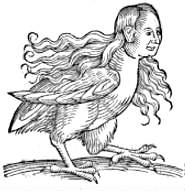 A harpy
A harpy
Obviously, these curiosities captured by Motz cannot have been barn owls, which weigh only about a pound and have heads that are completely coated with feathers. So what were they? Clearly, if they existed at all, they would have resembled the harpies of ancient myth (right). But could such a tertium quid have ever actually existed? Indeed, could such a thing have existed right here in the United States on an island in the Ohio River? Either this report is a hoax or a denizen of fable becomes something real.
Several other news reports about monkey-faced owls exist that refer to the birds in question as rare and curious freaks (report 1, report 2). These, however, lack the detail of the Parkersburg report. Indeed, they may simply refer to barn owls, but if so, the description of these creatures as rare would be odd since Tyto alba is one of the most widespread and common owls on earth.
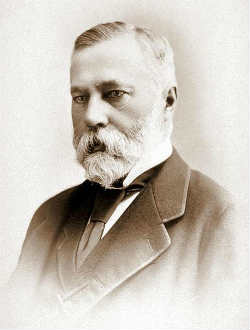 J. B. Haggin
J. B. Haggin(1822-1914)
Reports appearing in newspapers across the country in 1903 provide a second large piece in the monkey-faced owl puzzle. For example, it was reported that on the California ranch of James Ben Ali Haggin, known as J. B. Haggin, a “monkey” (not specifically identified) was allowed regular access to a cage of female burrowing owls (Athene cunicularia), also known as ground owls, and that mixed progeny resulted. Haggin was a millionaire attorney, rancher and horse breeder who struck it rich in the California Gold Rush. The Haggins ranch, the 44,800-acre Rancho del Pasco, outside Sacramento, carried on one of the largest horse breeding operations in the United States.
The following transcript was taken from the front page of the May 28, 1903, issue of Williston Graphic, a newspaper published in Williston, North Dakota (source), one of the many papers carrying this story.
OWLS LIKE MONKEYS
A Queer Family of Six, Born on a
California Ranch
They are a Puzzle to Naturalists and
Attract Scores of Curiosity Seekers
No Other Birds Like
Them Anywhere
Monkey-faced or barn owls are common enough, but the strange thing about this owl and his five brother and sister owls, with their monkey-like faces, is that they were hatched by a ground owl not half so big as they are, just a common every day ground owl that was probably as much surprised as anybody at her curious progeny.
The mother owl and two or three of her kind were caught some months ago and kept as pets by the men of Haggin’s ranch. Before they became part of the ranch family, a monkey had held undisputed right to the title of family pet. The monkey was an amiable, friendly creature, and not afflicted with jealousy; therefore, instead of feeling that the owls had put his nose out of joint, he became interested in them.
Day after day he went to the cage where the owls were kept, and sat and watched them. At last one day one of the men opened the door of the cage and let the monkey in. The monkey lay down in the cage content. The owls never so much as ruffled a feather or blinked a wide-open eye. The only trouble was to get the monkey to come out at night and go to his own cage.
The next day he went back to his friends and again he was allowed to go into the cage. This time he watched carefully how the door of the cage was opened and closed. It was an easy thing to do, and after that the men did not need to bother about letting him in and out. He could do it himself.
And every day he did it. No sooner was he taken from his own cage in the morning than he went straight to the owl’s cage, opened the door and walked in. There he would lie by the hour in silent satisfaction, apparently a welcome guest.
Meanwhile, one of the owls built her nest, laid half a dozen eggs, sat upon them, and in due time hatched out six owls that for all she knew were normal owlets. But as they began to take shape and color, they grew less and less like the mother owl.
Instead of having a rusty brown coat like hers, they were tawny, yellowish things, with white spots on their backs and wings. Instead of stopping they got to be as big as their mother, they kept on growing until they were twice her size.
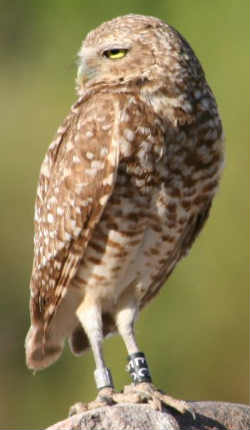 Burrowing Owl
Burrowing OwlAthene cunicularia
The owls subsequently escaped from their cage and were found three months later a long distance away. The finder is said to have sold the three for $1,000, while for the remaining three $200 has already been refused.
A report in the Los Angeles Herald, dated April 5, 1905, offered much the same information as the story quoted above. However, it added the following interesting details about the fate of the escapees:
About three months later one of the men from Haggin’s ranch went to work at a ranch near San Francisco, two or three counties distant. Here he learned that the niece of his employer had just caught a family of owls that had made their home among some brush and rocks not far from the ranch house. She had discovered six queer-looking owls as she started for a ride, and on returning home had determined to capture them. Putting on a pair of thick gloves, she went to where they were hidden among the rocks, and after a hard fight succeeded in getting them all into a box, which she just set outside the door.
What to feed the birds was a question. She offered them bread and grain, and they refused it. She tried vegetables, and still they refused. She had almost decided that the only thing would be to turn them loose and let them hunt their own food, when she was surprised to find another owl, only about half as big and of a different color, coming to the cage with a dead mouse in its claws. The faithful little mother had heard the cries of her young, and had come to bring them food. Every day the ground owl came with mice and insects, and this was supplemented by bits of raw meat and so the owls thrived. Miss Clark watched them with interest, unable to understand why the strange little brown owl should show such maternal interest in owls so unlike herself, until the arrival of the man from Haggin’s ranch.
In 1905, two years after the appearance of the story quoted above, Haggin, a Kentucky native who had been entering his animals in an ever increasing number of East Coast races, purchased Elmendorf Farm near Lexington, Kentucky, where he built what became the largest horse breeding operation in the United States. In the present context, the new location of his breeding stables is of interest in that Lexington is only about about 200 miles, as the monkey-owl flies, from Neal’s Island, where Henry Motz captured those three most peculiar birds in 1909 (see the report at the top of this page). Of course, this would not explain why Motz’ specimens weighed forty pounds. The California hybrids, which were supposed to be about twice the size of a burrowing owl, would have weighed no more than around a single pound. Perhaps Haggins and his stable hands were experimenting with larger owls and bigger
monkeys? Probably it was all a hoax. At this distance in time, who really can say?
In connection with the matters discussed on this page, it is perhaps worth mentioning that monkeys will, given the proper opportunity, choose to mate with birds. For example, a YouTube video shows a capuchin monkey mating with a duck (tinyurl.com/yaf6bjlf).
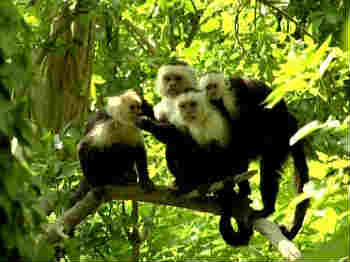 White-faced Capuchins
White-faced CapuchinsCebus capucinus
Although the monkey in the preceding account was not identified as to type, it seems likely that it was a capuchin monkey, the familiar organ grinder’s monkeys were capuchins, which were widely kept as pets during the nineteenth and early twentieth centuries. They have also long been used as jockeys in dog races. The burrowing owl comes into potential breeding contact with capuchins in Central and South America. A. cunicularia is a small owl, only a little larger than an American Robin (Turdus migratorius).
The following report, which is clearly related to the topic discussed above, appeared on page 7, column 4, of the May 25, 1891 issue of The Anaconda Standard, a newspaper published in Anaconda, Montana (Source):
By the same author: Handbook of Avian Hybrids of the World, Oxford University Press (2006).